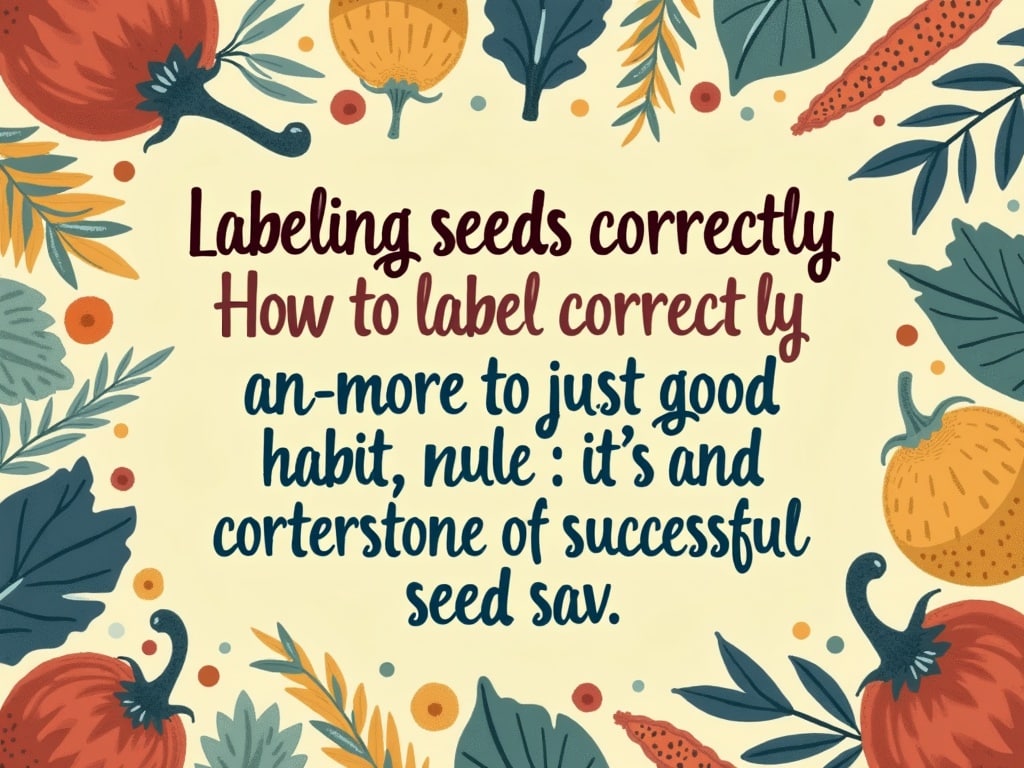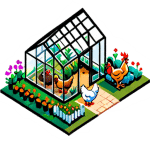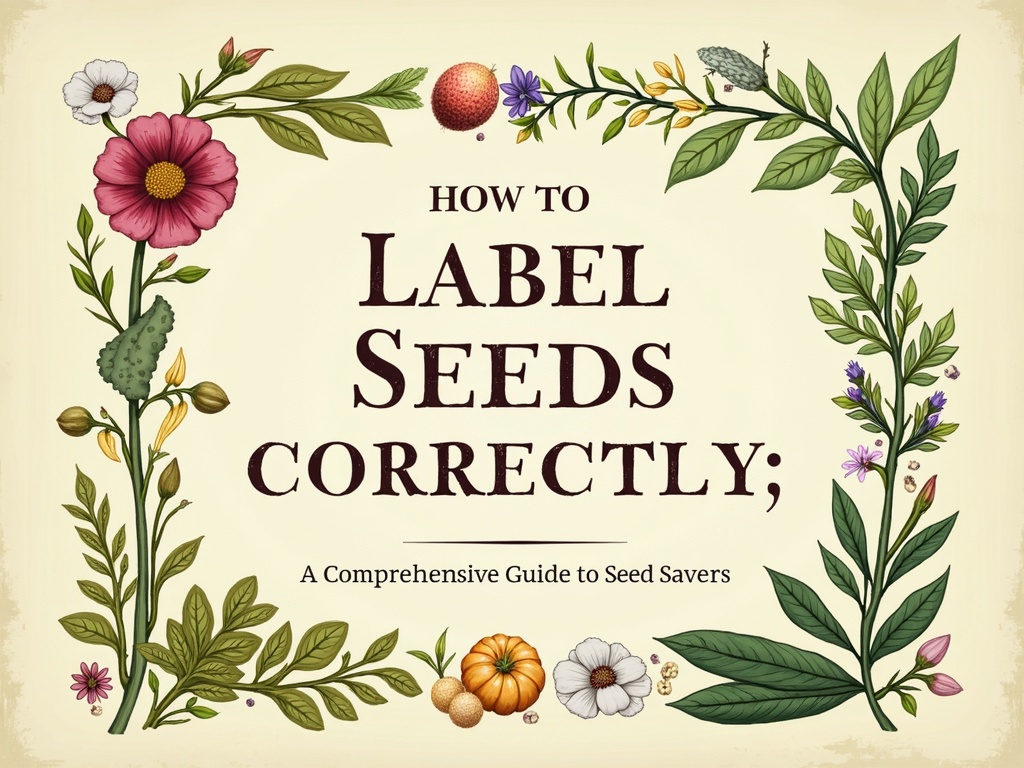How to Label Seeds Correctly: A Comprehensive Guide for Seed Savers
Imagine carefully nurturing a tomato plant, diligently saving its seeds, only to plant them the next year and discover they're not the heirloom variety you thought, but a bland hybrid. The culprit? A simple labeling mistake. Seed saving is a rewarding practice, but it hinges on accurate record-keeping. Knowing exactly what you're planting is crucial for preserving genetic diversity, maintaining desired traits, and avoiding unwanted surprises in your garden. This comprehensive guide will equip you with the knowledge and techniques to label your seeds correctly, ensuring your seed-saving efforts are fruitful for years to come.
Why Accurate Seed Labeling Matters
Labeling seeds correctly is more than just a good habit; it's the cornerstone of successful seed saving. Here’s why precision matters:
**Maintaining Variety Integrity:Knowing the exact variety of each seed allows you to preserve specific traits, flavors, and characteristics. Without proper labeling, you risk losing track of unique cultivars and their valuable genetic information.
**Preventing Cross-Pollination Confusion:If you're saving seeds from multiple varieties of the same species (e.g., different types of tomatoes), accurate labeling is essential to avoid accidental cross-pollination. Cross-pollination can result in offspring with unpredictable and potentially undesirable traits.
**Tracking Seed History:Detailed labels allow you to track the history of your seeds – their source, generation, growing conditions, and any notable observations. This information is invaluable for understanding how your seeds perform over time and making informed decisions about future plantings.
**Ensuring Accurate Germination Records:By noting germination rates on your labels, you can gauge the viability of your seeds and adjust your planting strategies accordingly. This helps you avoid wasting time and resources on seeds that are unlikely to sprout.
**Facilitating Seed Sharing and Trading:When sharing or trading seeds with other gardeners, accurate labeling is crucial for providing them with the information they need to grow the plants successfully. Clear labels build trust and ensure that your seeds are properly appreciated.
**Avoiding Unexpected Results:Imagine planting what you thought were your prized sweet peppers, only to discover they're fiery hot chilies! Accurate labeling prevents these kinds of disappointing surprises and ensures you're growing exactly what you intend.
Essential Information to Include on Your Seed Labels
What information should you include on your seed labels to ensure accuracy and clarity? Here’s a comprehensive list of essential details:
**Variety Name:The most important piece of information! Be specific and use the full variety name (e.g., ‘Brandywine Pink' tomato, not just ‘Brandywine').
**Species:Include the scientific name (e.g., *Solanum lycopersicumfor tomato) if you’re saving a diversity of plants from the same family.
**Source:Note where you obtained the seeds – whether you saved them yourself, received them from a friend, or purchased them from a particular seed company. This can be helpful for tracking the origin and quality of your seeds.
**Date of Harvest:Record the date you harvested the seeds. This information is crucial for determining seed viability, as germination rates tend to decline over time.
**Planting Date (Optional):The date you plan to plant the seeds can be useful for organizing your seed collection and planning your garden.
**Generation (Optional but Recommended):If you're saving seeds from plants you've grown yourself, note the generation (e.g., F2, F3). This indicates how many generations the seeds have been saved and can provide insights into their genetic stability.
**Growing Notes (Optional):Include any relevant observations about the parent plant, such as its size, yield, disease resistance, or flavor.
Descriptive Examples
Here are some examples of well-detailed seed labels:
**Tomato, ‘San Marzano', *Solanum lycopersicum*, saved from garden, harvested 09/15/2023, F2. High yield, excellent flavor.**
**Pepper, ‘Jalapeño', *Capsicum annuum*, Baker Creek Seeds, harvested 10/01/2023. Strong, productive plant.**
**Lettuce, ‘Black Seeded Simpson', saved from neighbor, harvested 06/20/2023. Fast-growing, heat-tolerant.**
Choosing the Right Labeling Materials
The materials you use for labeling your seeds are just as important as the information you include. Your labels need to be durable, weather-resistant, and easy to read. Here are some popular options, along with their pros and cons:
**Permanent Markers:A classic choice, permanent markers are readily available and easy to use. However, some markers can fade or bleed over time, especially when exposed to sunlight or moisture. Opt for high-quality, fade-resistant markers specifically designed for outdoor use.
**Pencils:Pencils are a reliable option for labeling seeds, as the graphite is resistant to fading and smudging. They’re especially useful alongside plastic or wooden plant markers. Use a soft pencil (2B or softer) for darker, more legible markings.
**Label Makers:Label makers provide a neat and professional look. Look for label makers that use thermal transfer printing, as these labels are more durable and water-resistant than those printed with inkjet or laser technology.
**Waterproof Paper and Ink:Waterproof paper and ink are ideal for creating durable labels that can withstand moisture and humidity. You can print your labels using a laser printer (laser ink is generally waterproof) or write on the paper with a waterproof pen.
**Plastic Plant Markers:Plastic plant markers are durable, weather-resistant, and reusable. They come in various sizes and shapes, and you can write on them with permanent markers or label makers.
**Wooden Plant Markers:Wooden plant markers offer a natural and rustic look. They’re biodegradable and can be written on with pencils or permanent markers. However, they may eventually rot or decay, especially in damp conditions.
**Metal Plant Markers:Metal plant markers are the most durable option, offering excellent resistance to weather and wear. They can be engraved, stamped, or written on with special metal-marking pens.
**DIY Options:Get creative with recycled materials! You can use cut-up plastic containers, popsicle sticks, or even smooth stones as labels. Just make sure to use waterproof markers or paints to write on them.
Tips for Choosing the Best Materials
**Consider Your Climate:If you live in a rainy or humid area, choose waterproof or water-resistant materials.
**Think About Longevity:If you plan to save seeds for many years, opt for durable materials like metal or high-quality plastic.
**Prioritize Legibility:Choose materials that are easy to write on and that provide good contrast with the ink or pencil you're using.
**Test Before You Commit:Before labeling your entire seed collection, test your chosen materials to ensure they hold up well to moisture, sunlight, and handling.
Methods for Labeling Seeds During Harvest, Drying, and Storage
When it comes to seed saving, labeling is a continuous process that begins at harvest and continues through drying and storage. Here’s a step-by-step guide to help you label your seeds correctly at each stage:
During Harvest
**Label the Parent Plant:Before you even harvest your seeds, label the parent plant clearly with the variety name and any other relevant information. This will serve as a visual reminder of the seed's origin.
**Use Temporary Labels:As you harvest seeds from different plants or varieties, use temporary labels to keep them separate. You can use small paper bags, plastic containers, or even masking tape with handwritten notes.
**Record Information Immediately:Don't rely on your memory! As soon as you harvest the seeds, record the variety name, harvest date, and any other essential information on your temporary label.
**Avoid Mixing Seeds:Be meticulous about keeping different varieties of seeds separate. Even a few stray seeds can lead to confusion later on.
During Drying
**Transfer to Drying Containers:Once you've harvested your seeds, transfer them to drying containers, such as paper plates, coffee filters, or mesh bags.
**Label the Drying Containers:Clearly label each drying container with the variety name, harvest date, and any other relevant information. Use waterproof markers or labels that won't be affected by moisture.
**Keep Varieties Separate:Maintain strict separation between different varieties of seeds during the drying process. Avoid placing drying containers too close together to prevent accidental mixing.
**Monitor Drying Progress:As your seeds dry, check them regularly for mold or mildew. Discard any seeds that show signs of spoilage, and make a note of it on your label.
During Storage
**Choose Appropriate Storage Containers:Once your seeds are completely dry, transfer them to airtight storage containers, such as glass jars, plastic containers, or seed packets.
**Create Permanent Labels:Prepare permanent labels for your seed storage containers. Use durable materials like waterproof paper, label makers, or permanent markers.
**Include Essential Information:Be sure to include all essential information on your permanent labels, such as the variety name, species, source, harvest date, and generation.
**Store Seeds Properly:Store your labeled seed containers in a cool, dark, and dry place to maximize their longevity. A refrigerator or freezer can be ideal for long-term storage.
**Maintain a Seed Inventory:Keep a detailed inventory of your seed collection, listing each variety, its origin, and its storage location. This will help you keep track of your seeds and plan your future plantings.

Advanced Labeling Techniques for Seed Saving
For serious seed savers, going beyond the basics can significantly improve the accuracy and organization of their seed collections. Here are some advanced labeling techniques to consider:
**Using a Numbering System:Assign a unique number to each variety of seed you save. This can be helpful for organizing your seed collection and cross-referencing information in a seed inventory or database.
**Creating a Seed Database:Create a digital database to store detailed information about each variety of seed you save. This can include the variety name, species, source, harvest date, generation, growing notes, germination rates, and storage location.
**Using Color Coding:Use different colored labels or markers to categorize your seeds by species, plant family, or other criteria. This can make it easier to quickly identify and locate specific seeds in your collection.
**Implementing QR Codes:Generate QR codes for each variety of seed and attach them to your seed labels. When scanned with a smartphone or tablet, the QR code can link to a detailed profile of the seed in your database.
**Taking Photos of Parent Plants:Take photos of the parent plants from which you save seeds. Attach these photos to your seed labels or include them in your seed database for easy visual identification.
**Documenting Growing Conditions:Keep detailed records of the growing conditions for each variety of seed, including soil type, watering schedule, fertilization, and pest control measures. This information can be helpful for understanding how your seeds perform in different environments.
**Tracking Germination Rates:Regularly test the germination rates of your seeds and record the results on your labels or in your seed database. This will help you determine the viability of your seeds and adjust your planting strategies accordingly.
Troubleshooting Common Labeling Mistakes
Even with the best intentions, labeling mistakes can happen. Here are some common errors to watch out for and how to correct them:
**Illegible Handwriting:If your handwriting is difficult to read, consider using a label maker or printing your labels instead.
**Faded or Smudged Labels:Choose durable labeling materials and waterproof markers to prevent fading or smudging.
**Missing Information:Double-check your labels to ensure they include all essential information, such as the variety name, harvest date, and source.
**Incorrect Information:If you discover an error on a label, correct it immediately. If you're unsure of the correct information, it's better to err on the side of caution and discard the seeds.
**Mixed-Up Seeds:If you accidentally mix up different varieties of seeds, label them as unknown rather than guessing their identity. You can try growing them out to see what they are.
**Lost Labels:Replace lost or damaged labels as soon as possible. If you can't remember the information on the label, it's best to discard the seeds.
Preventative Measures
**Develop a Consistent Labeling System:Establish a clear and consistent labeling system for your seed collection and stick to it.
**Double-Check Your Work:Before storing your seeds, double-check all labels to ensure they are accurate and complete.
**Store Labels and Seeds Together:Keep your seed labels and seeds together at all times to avoid mix-ups.
**Regularly Review Your Seed Collection:Take time to review your seed collection periodically to ensure that all labels are still legible and accurate.
The Importance of Seed Saving Communities and Knowledge Sharing
Saving seeds isn't just an individual endeavor; it's a practice deeply rooted in community and knowledge sharing. Connecting with other seed savers can provide valuable insights, resources, and support. Here’s why engaging with seed saving communities is essential:
**Learning from Experienced Seed Savers:Experienced seed savers can offer invaluable advice on everything from pollination techniques to seed cleaning and storage.
**Sharing Knowledge and Resources:Seed saving communities provide a platform for sharing knowledge, resources, and even seeds themselves.
**Preserving Rare and Heirloom Varieties:By sharing seeds and knowledge, seed saving communities help preserve rare and heirloom varieties that might otherwise be lost.
**Building a Local Seed Network:Connecting with local seed savers can help you build a resilient seed network that can withstand disruptions to the commercial seed supply.
**Promoting Biodiversity:Seed saving communities play a vital role in promoting biodiversity by encouraging the cultivation of a wide range of plant varieties.
Ways to Connect with Seed Saving Communities
**Join a Local Seed Saving Group:Search online or contact your local extension office to find seed saving groups in your area.
**Attend Seed Swaps and Exchanges:Seed swaps and exchanges are a great way to meet other seed savers, share seeds, and learn new techniques.
**Participate in Online Forums and Communities:Online forums and communities dedicated to seed saving offer a wealth of information and opportunities to connect with other enthusiasts.
**Take Seed Saving Workshops and Classes:Seed saving workshops and classes provide hands-on training and expert guidance.
**Visit Seed Libraries:Seed libraries are community-based resources where you can borrow and donate seeds.
Sustainable Seed Saving Practices
Seed saving is inherently a sustainable practice, but there are ways to make it even more environmentally friendly. Here are some tips for sustainable seed saving:
**Grow Open-Pollinated Varieties:Open-pollinated varieties produce seeds that are true to type, meaning they will grow into plants that are similar to the parent plant. This allows you to save seeds from year to year without losing desirable traits.
**Avoid Hybrid Varieties:Hybrid varieties are created by crossing two different parent plants. Their seeds do not typically produce true-to-type offspring, so they are not suitable for seed saving.
**Use Organic Growing Practices:Grow your seed plants using organic methods to avoid exposing them to harmful pesticides and herbicides.
**Conserve Water:Water your seed plants efficiently to conserve water resources. Use drip irrigation or soaker hoses to deliver water directly to the roots of the plants.
**Compost Plant Waste:Compost plant waste, such as leaves, stems, and fruit scraps, to create nutrient-rich soil for your garden.
**Reduce Packaging Waste:Use reusable containers and labels for your seeds to reduce packaging waste.
**Share Your Seeds:Share your saved seeds with other gardeners to promote biodiversity and reduce reliance on commercial seed companies.
Conclusion: The Rewarding Journey of Seed Saving and Labeling
Mastering how to label seeds correctly is an integral part of the enriching journey of seed saving. By taking the time to accurately label your seeds, you're not just preserving plant varieties; you're safeguarding a legacy of genetic diversity and knowledge for generations to come. Embrace the process, connect with fellow seed savers, and enjoy the satisfaction of growing your own food from seeds you've carefully saved and labeled. The rewards are abundant: a deeper connection to nature, a more resilient garden, and the joy of sharing the fruits (or vegetables!) of your labor. Accurate labeling isn't just a detail; it's the key to unlocking the full potential of seed saving.

